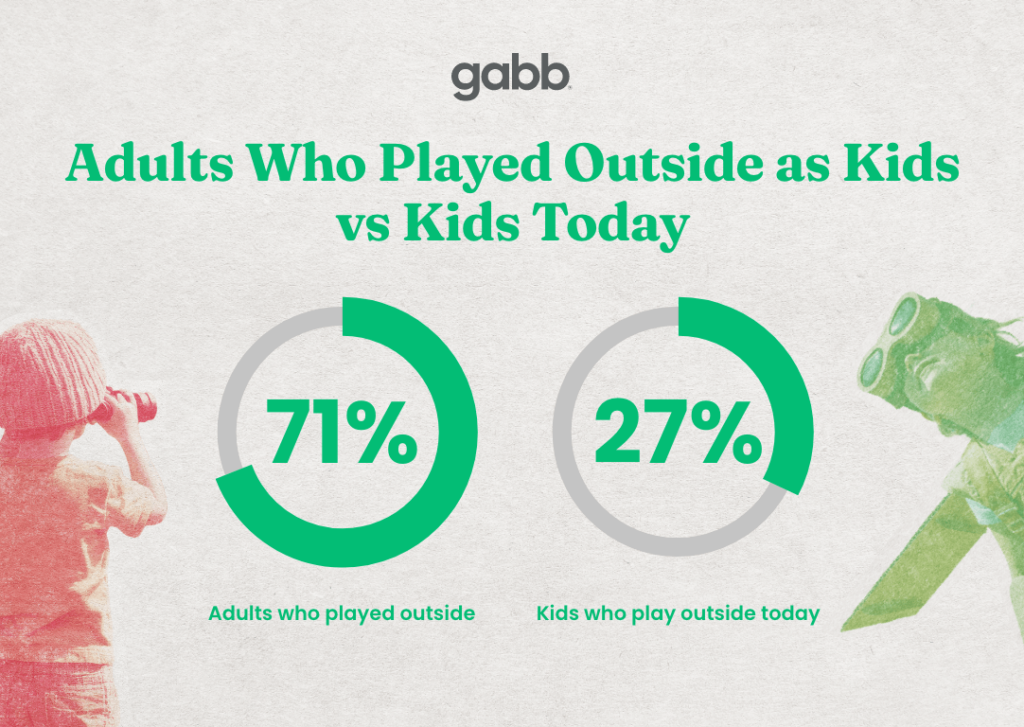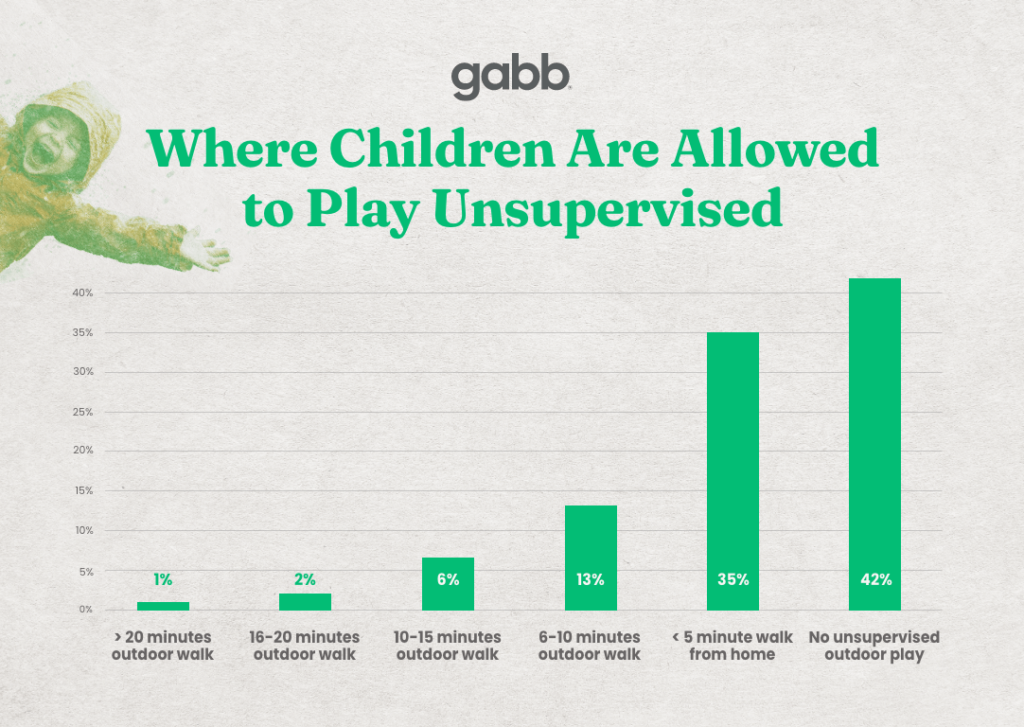Updated – Originally published June 30, 2022
Giving children the freedom to roam can be scary: What if they get hurt or lost? What if other kids or adults harm them? As parents, we know the risks. But we also remember what it felt like to ride bikes until the streetlights came on, explore the woods behind a friend’s house, or buy a candy bar with our own money.
That kind of unstructured freedom didn’t just give us memories. It gave us confidence.
Today’s kids don’t roam like we did — and we’re seeing the results. We all want to protect our kids — but sometimes the safest choice isn’t to hold on tighter, it’s to teach them how to walk further.
What is Independent Play?
When children have the freedom to explore their neighborhood safely, scientists and researchers call these experiences childhood independent mobility. This movement is crucial to social, emotional, and physical well-being.
Ideas to Encourage Exploration
What is Unstructured Play?
Unstructured play is child-led, spontaneous activity without adult direction. Also known as “free play,” it allows kids to create, imagine, and explore on their own terms. Or if you want a simpler unstructured play definition: unstructured play is when kids decide what to do, how to do it, and for how long — without grown-ups calling the shots.
Benefits of Unstructured Play
Unstructured play teaches children important life skills, encourages problem-solving, and promotes healthy development.
Children with more freedom to roam and play consistently get more daily physical activity, have greater motor skills, and are less at risk for obesity.
These kids also tend to have better social skills, show more self-confidence, feel more comfortable in social interactions, report less anxiety, have fewer feelings of loneliness, and experience many other benefits.
These ideas echo key insights from Jonathan Haidt’s 2024 book, The Anxious Generation — which explores how declining independent play and rising screen time are affecting kids’ mental health. For some quick insights, we’ve got the TL;DR right here.
So how does this kind of play differ from the structured activities kids also enjoy?
Structured and unstructured play
While structured and unstructured play are both important and fun forms of play, they have a few core differences.
Unstructured Play
- Organized and directed by the children involved
- Fun is the goal
- Child has autonomy and freedom to choose what they want to do
Structured Play
- Organized and directed by others
- Can have more than one purpose (to teach, occupy attention, or develop skills)
- Has expectations that shape how children should play
Roaming and Unstructured Play
Roaming is a significant part of unstructured play. The freedom to wander and explore expands opportunities for play and discovery.
Self-directed play is not only a natural desire young children have; it is a crucial part of healthy child development and yields many physical, social, and emotional benefits.
Declines in Roaming
Many parents recognize the value of roaming and unstructured children’s play, yet kids spend significantly less time with these activities.
As children, 71% of adults played in their neighborhoods daily, but just 27% of kids could say the same today.

Research points to several reasons for this trend but suggests that parental concern for child safety is the most common factor.
Surprisingly, community pressure plays a growing role, with 41% of children saying they’ve been told to stop playing outside by either a parent or other adult. Parents admitted they worry about disturbing neighbors, and many kids say they’ve been told not to make noise, climb trees, or play ball games outdoors.

Here’s the tricky part: even though most parents know roaming is valuable, our fears often override our intentions.
Misconceptions about roaming
It is natural for parents to be concerned about their children’s well-being. Parents are responsible for setting boundaries for their children’s safety, which is no easy task.
Unfortunately, misinformation can lead caregivers to overestimate dangers and create restrictions that might hinder children from exploring.
Due to these constraints, young children are more likely to roam digital landscapes instead of physical spaces. And digital landscapes often present more dangers to children than physical ones.

For example, in 2020, the National Center for Missing and Exploited Children received 37,872 online enticement records compared to 600 attempted abduction reports.
In other words, independent play outside may be discouraged, putting children in danger if they spend more time exploring the digital world.
Still, parents are the absolute authority when determining if allowing children to roam is safe. If a home is not situated in an environment where this is possible, a safe park or areas outside the city can be an alternative.
Tips for Concerned Parents
LetGrow invites parents to remember, “Simple precautions, not constant supervision, protect children from injury.” While no measure can guarantee complete safety, parents can feel more at ease when they follow basic guidelines like the ones below.
Get to know your neighbors
By many indicators, the world is safer today than it was 20, 30, or even 70 years ago, yet many parents feel it is more dangerous. One major reason is that people don’t feel as connected to their communities as they used to.
When today’s parents and grandparents grew up, everyone seemed to know everyone. Back then, parents could count on their neighbors and friends to look out for their children. We’re not parenting in the ’80s anymore — but our kids still need the same ingredients: freedom, play, and a little room to fall and get back up.

Despite this idealized view of the past, the facts show that community perceptions affect parental anxiety. Getting to know and establishing a relationship with your neighbors may give you greater peace of mind when letting your children roam.
Block parties, time on front porches, and a pick-up street hockey game are great ways to build friendships with those around us.
Set clear boundaries
Give your child space to explore, but show them where the limits are. These limits can be spatial (don’t go past the stop sign at the end of the street), but there are other kinds of boundaries you can put in place.
Let them know how far they can wander. You don’t have to helicopter. Try hanging back on the porch while they test their independence — you’ll be amazed at how capable they are. That first moment of letting go can feel scary. But it’s often where confidence starts — for them and for us. As the tiny tots mature, you can send them to the next aisle at the market and have them choose a cereal.
If you feel it is time, there are great communication options that provide GPS location tracking and alert your phone if they leave the safe zone.
Prepare kids to explore
Parents can teach and help their kids practice various skills to prepare them for when it’s time to play. Educating about how to make friends with other kids, what to do if they get lost, how to cross the street safely, and how to establish personal boundaries can go a long way.
One mom even let her young kids order their meals alone at a Chick-fil-A to help them build real-world confidence — no adult hovering nearby. It’s a great example of practicing independence in a safe setting.
3 Ways to Encourage Exploration
- Normalize Independence in Small Doses
- Let kids try manageable challenges that build confidence.
- Have them find a snack in the grocery store aisle on their own
- Let them knock on a neighbor’s door to ask a question
- Encourage short solo bike rides within a familiar area
- Make Safety Part of the Adventure
- Safety doesn’t have to be scary. Treat it like part of the learning.
- Teach them to look both ways before crossing the street and to spot street signs and crosswalks
- Help them recognize “safe adults” if they ever need help
- Equip them with an emergency phone so they can check in or call if needed
- Celebrate Curiosity and Self-Reliance
- Kids are more likely to explore when they know you trust them.
- Ask them what they discovered, who they met, or what they built
- Talk about moments when you got to roam as a kid
- Let them know it’s okay to say “no” if something doesn’t feel right — that’s part of being smart and strong
Take advantage of safe tech
GPS-enabled safe phones and watches can give parents peace of mind while letting their children explore. Parents can use these digital tools to know where their children are without being physically present.

Look for trackers that allow kids to send messages to their parents if they need help or want to check-in.
Examples of Unstructured Play
Consider these fun, safe activities to encourage unstructured play in your family.
- Arts and crafts: Give kids some pipe cleaners, yarn, popsicle sticks, or even simple crayons and construction paper and let them create.
- Cardboard box fort: Grab some cardboard boxes and paper towel roll cores and let your kids build a castle, spaceship, or whatever else they can come up with.
- Sidewalk chalk: If you have a driveway or a sidewalk in front of your house that isn’t heavily trafficked, let them practice being Picasso and create some chalk art.
- Water games: Some of the best unstructured play happens with the simplest of objects. Set your kids loose in the yard with bowls of water, measuring cups, and sponges of different sizes and watch them have a blast.
- Blowing bubbles: Purchase some bubbles at the store or find a recipe online to make your own.
- Play house: Make-believe games like house or dress-up are great ways for kids to use their imagination and explore their worlds.
Need more ideas? Check out our list of screen-free activities to bust boredom for every age and season.
Unstructured Play for Toddlers
Toddlers are wired to explore. While their worlds are smaller, unstructured play is just as vital for them as it is for older kids. At this age, it’s less about roaming the neighborhood and more about roaming their imagination.
Open-ended play helps toddlers develop motor skills, creativity, and emotional regulation. Think less “entertain them” and more “equip them.” Giving a toddler a box of blocks, a handful of scarves, or a pile of pillows lets them experiment, take risks, and discover what their little bodies and minds can do.
You don’t need Pinterest-perfect setups. The magic is in the freedom. When toddlers are given safe space to play how they want — even if that means stacking, dumping, or pretending — they’re doing the important work of becoming independent thinkers.
Unstructured Play for Tweens and Teens
Unstructured play isn’t just for little kids. Tweens and teens also benefit from screen-free time that’s self-directed and socially rich. For this age group, it might look like walking to a friend’s house, hanging out at the park, goofing off downtown, or biking to get a treat. These kinds of experiences build independence, decision-making skills, and real-life friendships — especially when phones stay in pockets.

Just like with younger kids, teens benefit from clear boundaries, community support, and safe tools like GPS watches or basic phones that let them check in without being tethered to a screen.
Conclusion
As parents, we don’t have to choose between affording our children the benefits of unstructured play or keeping them safe. With precautions and relying on our experience, we can have both.
The dangers of unstructured digital play are risky, even though it often occurs while kids are at home.










Success!
Your comment has been submitted for review! We will notify you when it has been approved and posted!
Thank you!